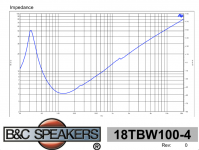Nickodeem,Until recent time I didn't realized that with each 6dB loss you need 4 times (not 2 times) more power in order to compensate for that. And therefore dipole's 6dB/oct drop is something really important, you cannot just ignore it. So regarding power demands and cone excursions I can summarize everything with a picture below (frequencies given for typical average H-frame and sealed woofer sizes like 50-60cm, they will differ from size to size, but to change the chart dramatically you'll need to change the woofer size dramatically too).
Power is measured in watts, amplifiers amplify voltage.
The impedance of a dipole woofer is very similar to it's free air response, at the free air resonance (Fs), impedance is highest.
If using a high pass filter below Fs, the actual power in watts the speaker uses is actually far less than what the voltage gain would indicate.
For instance, using the impedance chart below of a 4 ohm 33 Fs loudspeaker, with 2 volts applied at around 125 Hz, it would draw 1 watt from the amplifier (2Vx2V/4ohm=1).
If an additional 20dB equalization gain was applied to flatten the response to 30Hz, 20 volts would be required from the amplifier. The impedance at 30 Hz is 50 ohms, so the speaker would actually only draw 8 watts (20Vx20V/50ohm=8).
Amplifiers capable of high voltage output still are required, but actual power consumption is fairly low for dipoles appropriately high passed.
Attachments
You are right, I should mention voltage not power in my drawing since real power consumption indeed may be different for different drivers and frequencies. Voltage is just a bit unusual to add to drawings. We could read this as required max power capacity of the amp at those frequencies, in other words if an amplifier is rated as 36W @ 4 Ohms, then it is limited to 12 Volts peak to peak, at some levels that may be enough for vented but not for dipole and this difference (in amp max power rating) measures as x4 and x16 respectively, higher impedance only lowers actual power consumption/amp heating around Fs, but this is something listener would not notice since loudness won't be increased with higher impedance.
